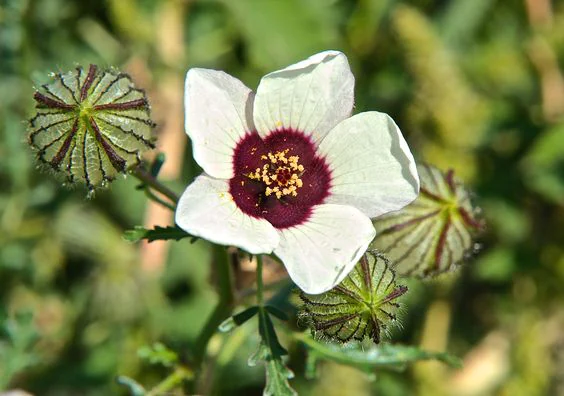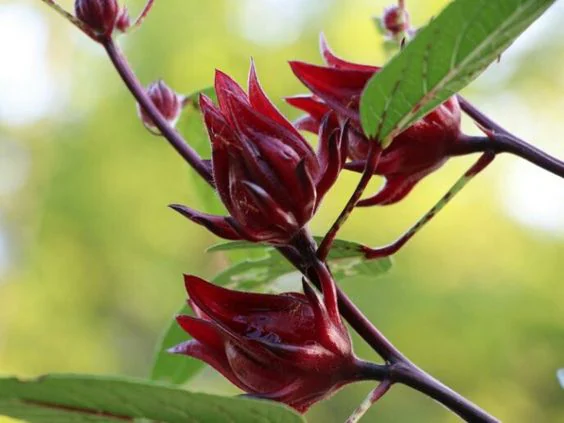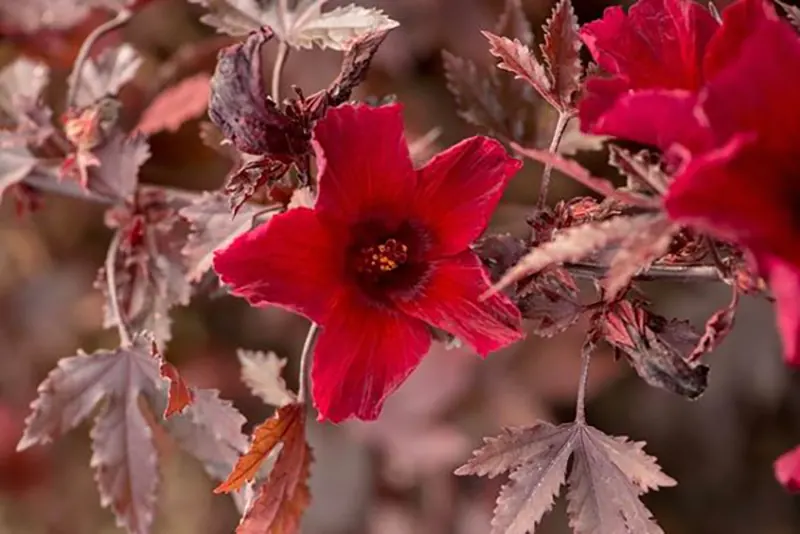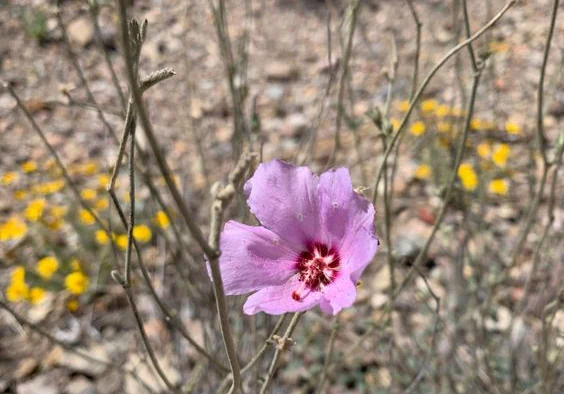The Many Faces of Hibiscus
Hibiscus is a genus of flowering plants responsible for producing some of the most beautiful intricate, and colorful flowers on the face of the Earth. You’ve no doubt come into contact with hibiscus rosa-Sinensis, a tropical species of hibiscus and by far the most recognizable species in the genus. You have either seen this magnificent large-format flower adorning the classic Hawaiian shirt or resting gently in the sparkling black locks of a generic Polynesian character.
Tropical hibiscus is incredibly beautiful and quite a sight to behold in person; however, in my humble opinion, hibiscus rosa-Sinensis is what I refer to as the gateway species.
Below, we’re going to venture further than this gateway species. We will take a comprehensive look at the many faces of hibiscus. There are over 200 species of hibiscus, but if we were to cover them all in this article, it would be part one of a novel trilogy. Therefore, I’ve hand-picked the seven most unique species I could find. I hope you find something truly unique within the words of this article, and that I can convince you to bring a Hibiscus, in any form, into your space.
Types of Hibiscus
Herewith we start down the path of uniqueness and beauty. Every single one of the plants I’ve selected below is unique from the next in some way. I believe that all flowers, even those within the same genus or species, are completely unique in some way, but for the purpose of this article, I wanted each flower I pick to be as different from the last as possible. You’ll see Hibiscus flowers here that you may never have seen before, and hopefully, a few that you have.
China Rose
Hibiscus rosa-Sinensis
Pinterest
Hibiscus rosa-Sinensis is the image many people see in their minds when they hear the name Hibiscus. This one species has somehow come to represent the entire genus. This is understandable, though. Chinese Hibiscus, or Rose of China, as it is also known, is one of the most popular species of Hibiscus and the species that many gardeners and horticultural enthusiasts opt for when selecting foliage and flowers with which to populate their gardens.
Even though this is called the Rose of China, you’ll find these beauties growing in the wild in many tropical and sub-tropical regions, such as the Polynesian islands, the Mediterranean, and Southeast Asia.
The Rose of China does best in full-sun conditions, so be sure to plant this bloom on the northern side of your home if you can. Here, it can bask in the rising and setting sun, as well as when the sun is overhead. This is not a particularly hardy plant, so you’ll need to keep it well shielded from frost and generally colder climates. As a bonsai, this species will do well indoors as well as out, but if you opt for an indoor bonsai, be sure to keep your Hibiscus rosa-Sinensis in a sunny spot. In terms of watering, two moderate waterings a week should be perfect for most climates. If you live somewhere uncharacteristically hot, you’ll need to water your Chinese Rose more often. While this plant doesn’t like wet feet, it also doesn’t take well to bone-dry soil.
Quick Care Sheet
Plant type: Perennial shrub
Native Area: Polynesian Islands, the Mediterranean, Southeast Asia, and China
Flower Color: Red, blue, orange, yellow, white, pink, and purple
Bloom Time: Summer and fall
Hardiness Zone: USDA 10-12
Light: Full sun and partial shade
Water: Moderate watering
Soil: Fertile and well-draining
Rock Hibiscus
Hibiscus denudatus
This is an interesting character. What we have here is known as Paleface hibiscus. This species is native to North America and boasts none of the typical physical structures or visual cues of the classic hibiscus plant. Rock hibiscus has been described as a scraggly plant, but I think this is one of the prettiest flowering plant species I’ve ever seen. Of course, from the perspective of a bonsai and horticultural enthusiast, that list is longer than Santa’s to-do list at Christmas time.
Even though visually, this plant looks a little parched with its dead sticks for shrubbery, it suits its native environment. You’ll find this desert-dwelling hibiscus across the southwestern United States and northern Mexico. If you live in California, Colorado, Nevada, or Arizona, this plant should feel perfectly at home in your yard. Rock hibiscus isn’t always a mass of dead sticks and pretty pink flowers; its foliage is light green and looks to be covered in fine white hairs. In an effort to maintain its flowers and reproductive functions, the leaves drop off during periods of intense drought.
As you may have guessed, this plant quite enjoys basking in the rays of the hot sun. Therefore, pick super sunny spot for these babies and they’ll be perfectly happy. Even though Rock Hibiscus can thrive on very little water, you’ll want to keep your plant hydrated during hot spells. This plant is best suited to sandy soils that drain well and does not like wet feet. If you choose to pot this Hibiscus, a sunny windowsill or north-facing room should do quite well.
Quick Care Sheet
Plant type: Perennial shrub
Native Area: California, Nevada, Mexico, Colorado, and Arizona
Flower Color: Pink and white
Bloom Time: Summer and fall
Hardiness Zone: USDA 7
Light: Full sun and partial shade
Water: Moderate watering
Soil: Fertile and well-draining
Flower of an Hour
Hibiscus trionum
Pinterest
This little beauty is called the Flower of an Hour, and it might take you an hour to rattle off all of the other names this bloom carries. In addition to its botanical name, Hibiscus trionum, this blossom also carries the names bladder hibiscus, bladder weed, bladder ketmia, shoofly, modesty, Venice mallow, and puarangi. It should be obvious from the names used to describe it that this particular species of hibiscus is rather invasive. This plant grows both as a weed and specifically chosen garden plant in urban Europe and the United States, although it originates in the Old World tropics. Old world is a term used here to describe the tropics of Africa, Asia, and Europe.
This is one of the dwarf species of hibiscus, growing to an average height of around 8-20 inches. Contrary to many of the dwarf species, this is a thirsty little plant. If you plant Hibiscus trionum in your garden, you’ll need to keep the soil moist – this means more frequent waterings than Hibiscus rosa-Sinensis. You’ll also need to ensure that your soil is rich in organic matter and fairly acidic. Loam works really well for this species.
True to the Hibiscus genus, this species loves to bask in the warm glow of the sun. This means a north-facing location is a perfect place for this little stunner. One interesting thing about Hibiscus trionum is that they’re one of the species that can pollinate themselves. If there are pollinators around, the style of this flower will remain in the perfect position to be pollinated. However, if there are no pollinators in the vicinity, the plant will take matters into its own reproductive bits and bend its style toward its anthers. This way, pollen from the plant’s own anthers can fertilize the egg and carry on the species.
Quick Care Sheet
Plant type: Perennial shrub
Native Area: Asia, Africa, Europe and the United States
Flower Color: White and crimson with dark green foliage
Bloom Time: Summer and fall
Hardiness Zone: USDA 9-11
Light: Full sun and partial shade
Water: Moderate watering
Soil: Fertile and well-draining
Rose of Sharon
Hibiscus Syriacus Pinterest
Pinterest
This is a truly unique species of Hibiscus, boasting multiple corollas to form an almost rose-like structure. The most popular varieties or cultivars within this species are White Chiffon and Pink Chiffon. This is a Hibiscus for the elegant gardener. In the horticultural world, these are what we refer to as showy flowers – and what a show they put on each year. This is an interesting plant. Apart from making the perfect bonsai, these pretties will do well as tall statement pieces, low-lying shrubbery, border shrubs, and even hedges.
Hibiscus syriacus is native to Southeast Asia and China but will grow vibrantly and profusely anywhere where it has access to the sun and fairly warm temperatures.
This magnificent shrub does best in full sun, but will also do well in partial shade. This means you could put this stunner anywhere and expect the same delicate, elegant blooms. Even though it requires rather fertile soil rich in organic matter, this bloom is incredibly easy to grow and an asset to any garden. You won’t need to pay much attention to your Rose of Sharon beds as these plants adapt well and self-seed aggressively if their conditions are satisfactory. Plant Hibiscus syriacus in well-drained but moist soils, and it will come back year after year with a spectacular show of colour. While the most popular varieties are soft pinks and whites, these shrubs also produce deep reds and vibrant blues.
Quick Care Sheet
Plant type: Perennial shrub
Native Area: Southeast Asia and China
Flower Color: White, pink, red, and blue
Bloom Time: Summer and fall
Hardiness Zone: USDA 5-8
Light: Full sun and partial shade
Water: Moderate watering
Soil: Fertile and well-draining
Roselle
Hibiscus sabdariffa
Pinterest
Finally, a Hibiscus you can eat. Well, to be fair, you can eat a great many species of Hibiscus, but Roselle is the perfect Hibiscus for the culinary gardener. If you’re a frequent face on the many recipe-based pages on Instagram or Pinterest, you will likely have seen these gems drenched in syrup or on a cutting board beside a jar of freshly made Roselle jam. We previously wrote an article on the culinary uses of Hibiscus, and this species was the star of that experience. This is an amazing plant to have in your backyard if you’re a frequent entertainer, and it brews the perfect tea to sip on a cool day.
Even though you’ve likely only seen the soft fleshy buds, this species of Hibiscus has a really stunning bloom. When in bloom, Roselle boasts small, white, pentamerous flowers that have a deep red eye. Quite eye-catching.
In terms of care, you’re going to love how easy this plant is to grow! You’ll need to plant this species in sandy loam, but you’ve likely come to expect this when a plant has anything to do with the Hibiscus genus. Roselle loves full sun and blooms better when basking in the light, like it’s contemporaries. Here’s the easy bit: You won’t have to fertilize this plant if your soil has the nutrients it needs. These plants are able to adapt really well and will thrive in a wide variety of conditions. That said, Roselle is sensitive to frost and won’t bloom if exposed to colder temperatures too frequently.
Quick Care Sheet
Plant type: Perennial shrub
Native Area: Tropical and sub-tropical Africa, west Africa
Flower Color: White and crimson with muted green foliage
Bloom Time: Late summer, fall, and winter
Hardiness Zone: USDA 9-12
Light: Full sun and partial shade
Water: Moderate watering
Soil: Fertile and well-draining
Confederate Rose
Hibiscus mutabilis Pinterest
Pinterest
Also known as the cotton rose, this is the most rose-like species within the Hibiscus genus. Like the Rose of Sharon, the Confederate Rose boasts multiple corollas fused to a singular calyx. Although the Confederate Rose looks more intricate and far more impressive. This species is also one of the more interesting among the Hibiscus blooms in that it experiences a rather drastic shift in color. Within the space of one to three days, the Confederate Rose typically shifts from white or light pink, to a deep magenta and darker pink, and then finally a dark red.
This is also one of the best species for bonsai cultivation, as the stems of the Confederate Rose grow tall and wide enough to resemble a tree quite naturally. This means you wouldn’t have to go through the same trunk thickening procedures as you would with a smaller Hibiscus plant.
For the best results, you should plant your Confederate Roses at the beginning of spring. Even though this plant is typically better suited to moist, well-draining soil, the Confederate Rose is known to be fairly hardy to drought. If you want to take full advantage of the brilliant blooms this species boasts, plant your Confederate Rose in the fullest rays of the sun and water well during the active growing seasons. You can plant this shrub in the shade, but it won’t flower as profusely as in the sun.
Quick Care Sheet
Plant type: Perennial shrub
Native Area: Southeast Asia
Flower Color: White, pink, magenta, and red
Bloom Time: Summer and fall
Hardiness Zone: USDA 7-11
Light: Full sun and partial shade
Water: Moderate watering
Soil: Fertile and well-draining
Cranberry Hibiscus
Hibiscus acetosella Pinterest
Pinterest
I’ve saved the most interesting for last. This is the Cranberry Hibiscus, also known as Hibiscus acetosella, a tropical variety with the most intriguing foliage. While most Hibiscus plants feature green foliage that is sometimes covered in a white fuzz, Cranberry Hibiscus has foliage in the most beguiling shades of burgundy and copper. If you’re a fan of the Japanese maple or the cultural pastime known as momijigari, you’ll love this species. In my opinion, Hibiscus acetosella could even give the most vibrant Japanese Maples a run for their money. Unsurprisingly, this species is primarily grown for its ornamental leaves.
Unfortunately, this is a woody perennial species. This means that, unlike some species, this one won’t last for a lifetime. Woody perennials tend to only last a few years before becoming too woody and sparse to keep putting on the magnificent show they once did. Even so, these shrubs are unique enough to still be a massive asset to any garden.
The best place to plant your Hibiscus acetosella is in full sun – no surprise there. This species will thrive in partially shady conditions, but you’ll experience a far more profuse blooming season if it is planted in full sun. Like most Hibiscus species, this one requires fertile, moist, well-draining soil. The best time to plant these copper-toned beauties is in the spring. This way, you’ll be treated to beautiful crimson blooms during the late summer, fall, and winter.
Quick Care Sheet
Plant type: Woody perennial shrub
Native Area: Tropical and sub-tropical Africa
Flower Color: Crimson with copper and burgundy foliage
Bloom Time: Late summer, fall, and winter
Hardiness Zone: USDA 8-9
Light: Full sun and partial shade
Water: Moderate watering
Soil: Fertile and well-draining
Final Word
The wonderful world of Hibiscus is a world of color and diversity. Nowhere else in the plant kingdom will you find such a unique genus that boasts as many different species with as many defining characteristics as this. I hope you’ve learned something new about a species you’ve not come into contact with before. Now, if you’ll excuse me, I’m off to fill in the gaps in my Hibiscus garden with more Hibiscus.








